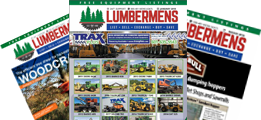As the forestry industry continues to expand, there is a growing demand for used forestry equipment. These machines offer a cost-effective solution for businesses looking to expand their fleet or replace outdated equipment. However, maintaining used forestry equipment is essential to ensure optimal performance, longevity, and safety. In this blog, we will explore comprehensive maintenance […]
How to Prevent Damage to Forestry Equipment
As the backbone of the forestry industry, robust and reliable equipment is vital for ensuring smooth operations and maximizing productivity. From chainsaws and harvesters to skidders and loaders, forestry equipment plays a crucial role in maintaining healthy forests and meeting the ever-increasing demand for wood products. However, the rugged nature of the forestry environment exposes these valuable tools to various hazards that can result in damage and costly repairs. To mitigate these risks, it is essential to implement preventive measures and adhere to proper maintenance and operation techniques. In this article, we will explore a range of practical tips to help you protect your forestry equipment from unnecessary damage, ensuring its longevity and optimal performance.
Overview of Forestry Equipment
Forestry equipment is designed to withstand tough and rugged terrain. This equipment is made up of heavy-duty materials to withstand the harsh conditions of outdoor operations. The equipment is used for a wide range of tasks, such as feeling, delimbing, bucking, skidding, and loading trees. The machines have different components, such as engines, hydraulics, tracks or tires, and hydraulic systems. Proper maintenance of these components is crucial for the equipment to function efficiently.
Importance of Preventing Damage
Preventing damage to forestry equipment is essential for several compelling reasons. Firstly, repairs and replacements can be costly, putting a strain on your budget and potentially affecting profitability. Secondly, damaged logging equipment can lead to downtime and delays, disrupting your operations and reducing productivity. Furthermore, a damaged machine poses a safety risk to operators and other workers in the vicinity, potentially leading to injuries or even fatalities. By proactively taking steps to prevent damage, you can mitigate these risks and ensure the smooth functioning of your forestry operations.
Tips to Prevent Damage
Here are some major tips to prevent damage to your forestry equipment
- Regular Maintenance
- Proper Operation Techniques
- Protective Measures
- Environmental Considerations
- Storage and Transportation
- Damage Assessment and Repair
1. Regular Maintenance: The Backbone of Protection
Regular maintenance is the cornerstone of preventing damage to forestry equipment. Follow the manufacturer’s recommended maintenance schedule, which typically includes tasks such as checking fluid levels, inspecting and replacing filters, lubricating moving parts, and tightening bolts and screws. By staying proactive with maintenance, you can identify and address minor issues before they escalate into major problems, saving you time, money, and headaches down the line.
2. Proper Operation Techniques: Mastering the Art
Inadequate or incorrect operation techniques can significantly contribute to equipment damage. Ensure that all operators receive comprehensive training on how to handle and operate each machine correctly. Emphasize the importance of following safety guidelines, including speed limits, weight capacity limits, and recommended cutting techniques. Encourage operators to be attentive and avoid overloading the equipment, as this can strain the machine’s components and increase the risk of damage.
3. Protective Measures: Shielding Your Investment
Investing in protective measures can go a long way in safeguarding your forestry equipment. Consider equipping your machines with appropriate guards, shields, and protective covers designed to shield vulnerable parts from impact, debris, and harsh environmental elements. Implementing additional features such as reinforced lights, grilles, and reinforced windows can provide added protection, particularly in challenging logging conditions.
4. Environmental Considerations: Harmonizing with Nature
The forestry environment poses numerous challenges to equipment durability. Familiarize yourself with the unique characteristics of the terrain, climate, and vegetation in your operational area. Adjust your equipment and operating practices accordingly to minimize damage. For example, in sensitive areas, consider using low-impact equipment or modifying attachments to minimize soil compaction and damage to nearby trees. Additionally, practice responsible land management by adhering to sustainable forestry practices, preserving the health of the ecosystem, and reducing the likelihood of equipment damage.
5. Storage and Transportation: Protecting Equipment during Downtime Equipment
Proper storage and transportation practices are essential for preventing damage during periods of inactivity or when moving equipment between job sites. When storing your equipment, ensure it is kept in a clean, dry, and secure location to protect it from rust, corrosion, and unauthorized access. Use appropriate covers or tarps to shield the machines from dust, moisture, and sunlight. During transportation, securely fasten the equipment, ensuring it is properly balanced and protected from vibrations, impacts, and road debris.
6. Damage Assessment and Repair: Swift Action for Optimal Recovery
Despite our best efforts, equipment damage may still occur. Promptly address any issues to prevent further complications and minimize downtime. Establish a systematic process for reporting and assessing damage, and ensure all workers are aware of the procedure. Train maintenance personnel to perform initial assessments and basic repairs and establish relationships with reputable equipment repair shops for more complex issues. By swiftly attending to equipment damage, you can restore functionality and prolong the lifespan of your machinery.
Conclusion
Preventing damage to forestry equipment is essential to ensure that the equipment remains in good working condition. This means that you should follow the manufacturer’s instructions on how to maintain the equipment. You should also operate the equipment within its capacity, use protective measures, consider the environment, store and transport the equipment properly, and carry out regular inspections and repairs. Taking these steps will help to prevent costly downtime and production losses while ensuring that the equipment is safe to use.






